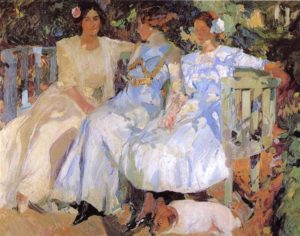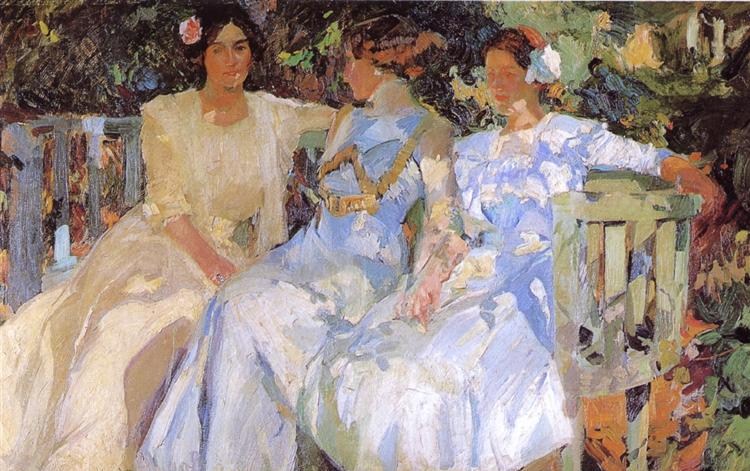11 April 2019
Sorolla: Spanish Master of Light
The National Gallery 18 March – 7 July 2019
Reviewed by William Morton
 Before going, I was somewhat dubious about this Exhibition. Knowing little about the Spaniard, Joaquin Sorolla (1863-1923), except that he painted beach scenes, it seemed possible that his work might be like that of Russell Flint – topless girls in romantic locations. Not so. He was a painter of great variety, was accomplished technically, thoughtful about his work and conversant with that of Velazquez and Goya. He was one of those happy artists who enjoyed great success during their own lifetime. From an early stage of his career, his paintings were bought by institutions such as the Spanish State and the City of Venice.
Before going, I was somewhat dubious about this Exhibition. Knowing little about the Spaniard, Joaquin Sorolla (1863-1923), except that he painted beach scenes, it seemed possible that his work might be like that of Russell Flint – topless girls in romantic locations. Not so. He was a painter of great variety, was accomplished technically, thoughtful about his work and conversant with that of Velazquez and Goya. He was one of those happy artists who enjoyed great success during their own lifetime. From an early stage of his career, his paintings were bought by institutions such as the Spanish State and the City of Venice.
At one period, he painted works with a social theme. In Packing Raisins, a room full of women sorts the fruit and there is a real sense of concentration and a harsh environment. Perhaps the most striking of these paintings is Sad Inheritance, a grim scene in which boys disabled as the result of the sexual diseases or alcoholism of their parents, are taken to bathe in the sea by a priest, a slightly sinister figure in his black robes. The Exhibition has some of the preparatory sketches for the picture. In one, boat sails appear on the horizon but they lighten the mood and are not included in the final version. Another of the social pictures is Sewing the Sail, which is used to publicise the Exhibition. The scene of a fishing family is very colourful and full of detail but somewhat chocolate-boxy.
Sorolla was a very respectable portrait painter and there are some fine examples in the Exhibition. Many of them are of members of his family such as the Goya-reminiscent one of his daughter, Maria with Mantilla. and one of his wife, Clotilde in a Black Dress. His portraits do convey something of the character of the sitters, who included the King of Spain and US President Taft.
The beach scenes themselves are splendid, with a contrast between those of fishermen and their boats and those of wealthier holidaying families. Fine examples are Running along the beach, in which a boy chases two girls and is full of movement and fun, and The White Boat, Javea where boys cling to an anchor rope and the reflection of the boat on the water is skilfully done. Sorolla himself considered The Pink Robe one of his most successful works. In it, two women exchange confidences in a bathing hut full of light and the figure of the one in the eponymous bathing dress is reminiscent of a classical statue.
In 1908, Sorolla acquired a wealthy American patron, Archer Huntington, the founder of The Hispanic Society of America, who invited him to hold an exhibition at the Society’s premises in New York, which was an enormous success. Subsequently, Huntington commissioned him to paint 14 large murals, The Provinces of Spain, for the Society’s library. This project occupied him for some years and he travelled all over the country doing preparatory sketches of landmarks and traditional peasant dress in different areas. Some of these, pictures in their own right, are in the Exhibition and give a fascinating insight into Spain at the time. One wonders when regional dress died out.
Sorolla is classified as an Impressionist and his paintings bring to mind leading Impressionists and bear comparison to their work. His Walk on the Beach of two women, one with a parasol, strolling at the water’s edge reminds one of Monet, his Burgos Cathedral under Snow of Pissarro. One of his most successful impressionist works is the colourful and vibrant My Wife and Daughters in the Garden, which fully justifies the title of ‘Master of Light’.
All in all, an enjoyable Exhibition well-worth visiting.


